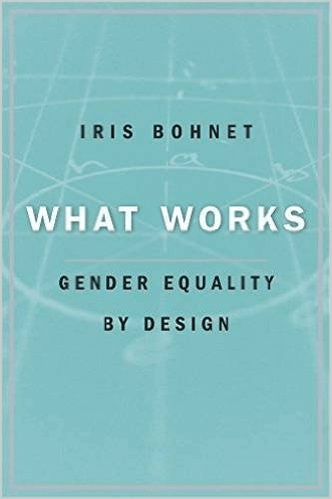How Behavioural Economics Can Help Improve Gender Equality
17 October 2017 - Author : Laetitia VitaudWith behavioural economics champion Richard Thaler winning the Nobel Prize in Economics this year, the discipline is now becoming mainstream. Behavioural economics was once a controversial approach to tackling economic issues because it integrates psychology in its analysis of how people make decisions. Unlike classical economists who give impetus to rationality and logic, behavioural economists focus on understanding the way we actually are — that is, irrational.

Richard Thaler and Cass Sunstein’s best-selling book Nudge: Improving Decisions about Health, Wealth, and Happiness, published in 2008, popularised the idea that homo economicus is nothing but a fallacy: we all make mistakes and we are all biased. But even that irrational behaviour can be modelled and predicted. By understanding how biased we really are, we can also strive to design a different choice architecture and nudge ourselves and others into behaving differently.
For years now, behavioural economists have studied the subject of gender inequalities. A new book by Iris Bohnet, professor of public policy and behavioural economist at Harvard Kennedy School, offers a compelling big-picture overview of the studies on the subject. The book, titled What Works: Gender Equality by Design, offers precious, sometimes counter-intuitive, insights into how behaviour can be nudged towards more equality.

Many politicians and executives pay some lip service to the importance of gender equality, which is now largely presented as both a moral and a business imperative. But many of the traditional policies implemented to advance diversity and equality have proved to have had little impact. Sometimes they have even backfired. And yet, Iris Bohnet writes, quite a lot can be achieved at relatively low cost when you understand the biases that prevent gender equality.
Why we just have to accept that bias is everywhere
Because it is often unconscious, bias is everywhere. When it comes to looking at men and women in a gender-neutral way, the business world isn’t free from those biases. As shown by the “Heidi-Howard study” already mentioned by Sheryl Sandberg in Lean In, women who violate norms face a social price: they will either be seen as “likable” or as “competent”, rarely both at the same time. Dozens of studies have now demonstrated the reality of the trade off many women face.
“Heidi Roizen was a successful Silicon Valley venture capitalist who became the subject of a case study at Columbia Business School. Professor Frank Flynn, presented half his class with the case study with Heidi’s name on it and gave half the class the same case study with her name changed to “Howard”. The students rated “Howard” and Heidi, equally competent, but they liked Howard, but not Heidi.”
Several online tests, including the now famous Implicit Association Test (IAT), have been developed by researchers to show how widespread our human biases are. Hundreds of thousands of people have thus discovered they weren’t immune to biases.
As analysed by Thinking Fast And Slow author Daniel Kahneman, another Nobel prize laureate, we rely on two modes of thought: “System 1” is fast, instinctive and emotional; “System 2” is slower, more deliberative, and more logical. We need System 1 to assess information quickly, which requires that we rely on categories represented by archetypes, whereas System 2, based on conscious reasoning requires much more effort and time. In other words, we just wouldn’t have enough time and energy to use System 2 continuously, so we need the “easy way out”. There is nothing more natural than biases.
“A general “law of least effort” applies to cognitive as well as physical exertion. The law asserts that if there are several ways of achieving the same goal, people will eventually gravitate to the least demanding course of action. In the economy of action, effort is a cost, and the acquisition of skill is driven by the balance of benefits and costs. Laziness is built deep into our nature.” (Daniel Kahneman)

Why a lot of gender equality policies have had little impact, or have even backfired
It turns out that “de-biasing” our minds is exceedingly hard. Often bias awareness has little impact on eradicating bias: it works only when the bias can be attributed to others. “People are quite ready to see bias in others, but they overlook the same biases in themselves”, writes Iris Bohnet. Therefore, a lot of the “diversity training” programmes offered in companies have had disappointing results.
One common bias that stands in the way of policy effectiveness is known as the “Halo Effect”, a term coined by psychologist Edward Thorndike: it refers to the fact that first impressions have such a long-lasting and powerful effect. Good-looking people are perceived as more intelligent, more successful and more popular. The effect is caused by a cognitive bias, the tendency for an impression created in one area to influence opinion in another area. (In marketing, the term is used to explain customer bias toward certain products because of favorable experience with other products made by the same company) (See the Wikipedia article for more).

Another common bias that prevents diversity training programmes from being effective is the “moral licensing” that it can generate, as people respond to having done something good (raising awareness on inequalities, for example) by doing more of something bad. If for example, you have eaten a low-calorie salad, you may feel licensed to eat a chocolate cake next.
Moral licensing is a relatively new field of inquiry, that has been demonstrated in a number of domains. It could explain why diversity training programmes can backfire. Managers who have promoted those programmes may feel they have “done enough”, feel morally superior, and therefore feel licensed to go back to their usual ways.
“Moral licensing is a a particularly interesting mental glitch: apparently, doing something that helps to strengthen our positive self-image also makes us less worried about the consequences of immoral behaviour, and therefore more likely to make immoral choices. For example, studies have shown that people who have just expressed strong disagreement with sexist statements are more likely to then hire a man for a job in a male-dominated industry, because they feel secure about their “non-sexist” self-image and therefore pay less attention to the possible biases they might have. It seems that being “good” is where the slippery slope towards being “bad” starts.” (Moral Licensing: How Being Good Can Make You Bad)
When it comes to negotiating, “doing it yourself is risky”
Negotiating matters a lot: those who ask for better compensation tend to be considerably better off than those who don’t. And most women tend to refrain from negotiating their employer’s initial salary offer. (See the book Women Don’t Ask by Linda Babcock and Sara Laschever)
“Even when women can imagine changes that might increase their productivity at work, their happiness at home, or their overall contentment with their lives, their suppressed sense of entitlement creates real barriers to their asking. Because they’re not dissatisfied with what they have and not sure they deserve more, women often settle for less.” (Women Don’t Ask)
According to Iris Bohnet, a simple behavioural “hack” can help improve women’s negotiation outcomes and mitigate the social consequences of asking: women should “embed their requests in a larger organisational context” or negotiate on behalf of somebody else, as the negotiation dilemma disappears when women negotiate for someone else.
Why data should be applied to people decisions
Few tools promise to transform management as profoundly as big data applied to human resources. “People analytics” in its simplest form collects large amounts of data and uses complex applications to measure relationships between variables to detect trends. Google is a pioneering company in that new field, applying data to people decisions like no other company in the world. As turnover is a growing concern for most companies—it is expensive to find, recruit, train and retain talent— relying on big data is an effective way to predict people’s likelihood of leaving.
People analytics as a discipline doesn’t only consist in using big data to make more informed decisions, it also relies on the idea that everything can be experimented with. Google’s iterative approach (nothing is perfect until it is improved 1000 times) applies to HR as well. But the idea of “experimenting” is not popular with all organisations.
Iris Bohnet writes about how Harvard University converted to Google’s data-driven approach to close the gender gap. They started measuring everything because “what does not get measured does not count” et “what does not get measured cannot be fixed”. That is how the university discovered that certain individuals particularly mattered to students: the visiting guests. So, besides faculty professors, the school started including a gender breakdown of their guests to offer more female role models to the students.
Why “the paradox of meritocracy” makes equal pay complicated
It turns out that evaluation is fraught with many biases. Emphasising meritocracy sounds like a good solution, but it often leads to more skewed performance rewards. Emilio Castilla, a professor of management at the MIT Sloan School of Management, wrote an article on the subject that became world famous. In it, he wrote that managers who insist their organisation is strictly meritocratic are more likely to present the biases that their meritocratic organisation is supposed to prevent.
This counterintuitive idea could be due to the fact that when managers believe they can rely on company policies to promote meritocracy, they can be less mindful about their individual decisions—and be “morally licensed” to be more biased in their individual decisions. To counter what Castilla calls the “paradox of meritocracy,” more accountability and transparency are called for. Managers who are held accountable before each of their decisions will make more just decisions.
How evaluation can be designed to be fair
Gender biases hurt organisations: employees who feel discriminated against are less motivated to work and more likely to quit. Although most managers like their discretionary power, there are solutions to improve evaluation procedures. When evaluators look at candidate profiles individually, they easily fall prey to group stereotyping, but when these evaluations are comparative, evaluators naturally focus more attention on individual performance rather than group stereotypes.
Furthermore, opting for group evaluations (many evaluations at the same time) has proved to be more conducive to diversity: “variety is more likely to emerge when people make multiple decisions simultaneously rather than sequentially”. “Such variety-seeking with simultaneous choice has been documented repeatedly”.
Evaluators are at risk of falling prey to “group think” if they make their evaluations in a group, so independent assessment, uninfluenced by what the other interviewers think is to be preferred. Groups can reach better decisions, but only if they adopt more structured processes.
As Iris Bohnet sums up in her book, there are three key points to create smarter evaluations procedures:
- Evaluate comparatively and hire or promote in batches;
- Remove demographic information from job applications (tools like GapJumpers and TalentSonar can help: they provide recruitment platforms that anonymise the gender and race of the applicant);
- Use structured interviews to evaluate candidates.
How to attract the right people to your organisation
The messages used in job ads, newsletters, web pages and blogs is rarely gender-neutral. Many linguists have pointed out that language is in fact gendered. Women will be less likely to apply for jobs that they perceive as “male-labeled”. “Gendered wording tells the applicants something about whether or not they “belong”” (even though wording does not affect whether or not they think they have the skills to do the job). Sometimes the gender effects of our messages cannot be understood without some experimenting.
Women consistently tend to place more value on flexibility. So flexibility should become the norm. As a default, “flexibility unless proven not to work” would change the structure of work. Bohnet cites the case of Telstra, Australia’s leading telecommunications and technology company, that made flexibility by default the norm. “Flexibility applies to every role at Telstra”. The company had many more applicants and many more women.
“With increased demand for flexibility, we can anticipate that competitive labor markets will adjust to employees’ preferences and stop discriminating against people seeking flexibility.” (Iris Bohnet)
On the importance of creating role models
The criticality of role models has been cited in many books and studies. “Seeing is believing”. Only when people can see counter-stereotypical role models often, will their beliefs start to change. The lack of visible role models creates self-fulfilling prophecies.
The US government understood this perfectly when they sought to recruit women for “men’s jobs” in factories. They supported their effort by an extensive marketing campaign to help women picture themselves taking a “man’s job” without losing their femininity. Rosie the Riveter has been a cultural icon in the US since then.

The evidence is overwhelming that role models influence behaviour. So promoting them to attract for women is key. Sometimes it might take some imagination. For example, Harvard has diversified the “portraits on the walls”.
Why incremental change can be counterproductive
How groups are composed in organisations matters a lot. It has been shown that at school both girls and boys do better when there are female students in the class room. The larger the share of women in the group, the higher the social intelligence of that group. To give more weight to the individuals who don’t speak up as much, some group rules can be established: “groups might want to constrain themselves from speaking freely”.
But until a “critical mass” can be achieved in that group, homogeneous groups are to be preferred, Bohnet writes. In other words, if you have only one (or two) women in an otherwise male group, the group will not benefit from that diversity.
“In groups dominated by one social type, members of the minority group are likely to be treated as tokens among their peers.”
Differences tend to be stressed, compelling the token member to adopt the majority’s style and opinion. That’s why the “lonely woman at the top” suffers from the “Queen Bee Syndrome”. Rather than pave the way for those who follow them, token members look up to their majority peers and distance themselves from new entrants of their own social category.

By contrast, in more balanced groups, stereotypes will lose their importance and individuals can prevail. That is why a critical mass must be achieved for diversity to be enriching. Many argue that a critical mass of one third in relative terms and at least three in absolute terms is required. Bohnet argues that until a critical mass can be assured, homogeneity is to be preferred. Incremental change (one “diverse” member at a time) is therefore counterproductive.
Therefore Iris Bohnet views gender quotas rather positively; “they boost the participation of well-qualified but previously underrepresented individuals. Far from elevating the under-qualified, quotas prove in fact to broaden the pool of qualified candidates”. She insists that whether or not quotas should be introduced remains a political decision that consists in weighing their benefits and their costs.
Why new norms have the power to change behaviour
Messages that have the most impact generally tell readers about what other people do and point out that you are the outlier. Sharing such information establishes social norms. So even though, it isn’t rational, people are more likely to vote when voter turnout is high and stay at home if everybody else is. People tend to be “conditionally cooperative”, i.e. more likely to contribute to public goods when others do so as well. They spurn free-riders more than they value public goods.
Studies suggest we can turn descriptive norms—what people are already doing—into prescriptive norms just by telling people about them. “What is becomes what should be” because of “herding behaviour”. So, for example, when people are informed about how sexist other people are, they become more sexist, not less!

“Norm entrepreneurs” in organisations and in public policy can promote positive behaviours by leveraging people’s innate desire to imitate others, compete with them and/or gain social approval.
Why increasing transparency remains the most powerful tool
Too often, disclosure requirements are poorly implemented and have but limited influence. To be truly transparent, information must be salient, visible and simple. Also, the more information is put into a comparative context, the more people are able to understand it. The more simple, the most effective.
Public ratings of restaurant hygiene, for example, have been in the US and the UK a highly effective intervention in transparency and have pushed restaurants to improve their hygiene.

A number of countries are now using the “comply-or-explain” approach to promote diversity:
“Most of us declare ourselves for gender equality, and nearly all employers would assure that their desire and intent is to hire the most talented employees. It is not unlike the majority of us who agree that eating healthily is a good thing. But when offered a choice between French fries and a salad as a side, many of us select the fries—much like the employer who, confronted with a choice between a more qualified candidate and one who shares his love of baseball, goes with ‘fit’ instead of ‘ability’.”
So when it comes to transparency, only salient, simple and comparable information will have some impact. Long-term and short-term achievable goals should also be set. And some form of accountability must be demanded for the follow-through of these goals. Iris Bohnet’s book offers precious insights into how to achieve that.


